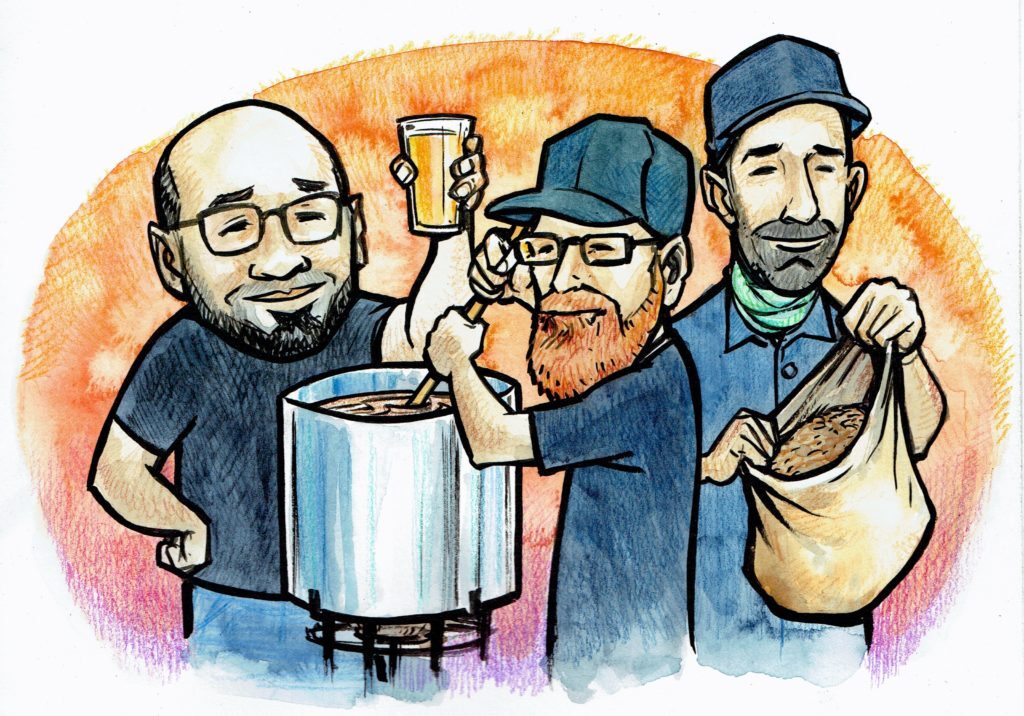
Chip Walton, Michael Dawson, and Jake Keeler are the minds behind one of the most enduring video series on
homebrewing ever made, Brewing TV, which marks its 10th anniversary in 2020 // Illustration by D.Witt
Ten years ago, when we all had faster metabolisms and fewer kids, the three of us worked together at Northern Brewer and started a web series titled Brewing TV. Because the internet is forever, you can still find those episodes.
The topic was brewing, both home- and pro-. Chip’s friend Art (Abstract Artimus) recorded our lyrically sparse but hypnotically catchy theme song. Filming and producing took us to a lot of basements, garages, conventions, brew decks, and cellars near and far. There was a fair bit of alchemy and a lot of figuring it out as we went—not unlike homebrewing itself.
The beer itself wasn’t the only thing that was homebrewed—did you know that, given enough hoodies and parkas stuffed against the windshield, the front seat of a Subaru makes a pretty decent sound booth for recording voiceovers? We also got very good at mic-ing up through and around beards. Some of it worked (we won a Best of iTunes award for podcasts in 2011), some of it didn’t (check out the never-before-aired lost episode. BTV Episode 0 on Chip’s Chop & Brew webcast). Apparently, an awful lot of viewers went on to open breweries of their own, which is both humbling and amazing, and also something we’ve heard often enough that our wives are all bored by it.
Also as in homebrewing, there’s no substitute for experiential learning (Szechuan peppercorns in saison must be experienced firsthand, because you won’t believe us if we just tell you it smells and tastes like shampoo). You’ll never know what works and doesn’t if you don’t mash up some disparate elements… although now that we think of it, one could also just read a book and figure it out that way, but that doesn’t make for good stories.
In observance of BTV’s 10th anniversary, here’s another mash-up of disparate elements greater than the sum of its parts.
VIDEO: Artimus Pils brewed and split-fermented with two lager yeast strains: Imperial Yeast Hygge Danish lager yeast and Fermentis SafLager S-23 German lager yeast.
Artimus “Pils”
Target OG: 1.050, Target IBU: 40
Shopping list
Grain
- 8½ lbs Weyermann® Floor-malted Bohemian Pils
- 4 oz CaraFoam
- 4 oz Dingemans Aromatic
Hops
- 2 oz Czech Kazbek
- ½ oz Sterling
Yeast
- Mangrove Jack’s Voss Kveik or similar—Omega Hornindal, Imperial Loki or Kveiking, etc. See Variations below for other yeast ideas for this beer.
Key Points for Key Pints
“Pils” Abstract Artimus is a determined Pils hunter—he relates that some of his favorite hoppy yellow lagers come from Threes Brewing in NYC, Blue Pants in Alabama, and Summit from right here in Minnesota. But we’re putting this recipe in quotation marks because it’s fermented with…
Kveik. Don’t make a yeast starter, let it run hot, and make sure to scream at it during fermentation. For more on brewing with kveik, visit Chop & Brew, or check out Lars Marius Garshol’s blog and his new book “Historical Brewing Techniques: The Lost Art of Farmhouse Brewing”.
Kazbek & Sterling. We’re using a couple brothers from other mothers: Kazbek from Czechia and Sterling from the U.S. have common Saaz parentage. This gives them a shared spicy, noble hop-esque quality, but with added elements of fruit and citrus as a result of their wild Caucasus mountain landrace and Cascade ancestry, respectively.
Variations. Much like its namesake Abstract Artimus, this beer is good for endless riffing: sub in your favorite lager yeast for the kveik and make it a true Pilsner; add some juniper or spruce and make it more Norwegian farmhouse-ish. Use a German ale yeast and call it an over-hopped Kölsch, or a Belgian ale strain and call it an over-hopped Enkel or Patersbier; trade out Kazbek and Sterling for Mosaic and Citra and use London Ale III or Conan and you’ve got an Abstract Hazy IPA.
To the homebrewery!
Note: these steps are general guidelines and assume you’re already familiar with the all-grain brewing process—refer to the instructions for your brew system, and adjust as needed based on experience with your own particular equipment.
Prep
- On brew day, collect strike water (we’re using 1.3 quarts per pound, YMMV) and heat to approximately 165 degrees F.
- Mill the base malt, or have it done for you at the shop.
Mash & Sparge
- Add all grains to strike water and mix to achieve a uniform temperature of 152–154 degrees. Rest the mash at this temperature for 60–90 minutes.
- While the mash rests, collect and heat sparge water.
- When the mash rest is complete, heat it to 170 degrees for mashout.
- Sparge and collect the wort in the boil kettle.
Boil
- Bring the wort to a boil and ponder the fleeting nature of time. Add 1 ounce Kazbek hops when the wort begins to boil, and boil for 60 minutes.
- 20 minutes before the end of the boil, add 0.5 ounce Kazbek hops.
- When the boil is finished, turn off the burner. Add 0.5 ounce each Kazbek and Sterling hops; cover the kettle and let rest for 20 minutes prior to using the wort chiller.
- Proceed with cooling the wort.
Fermentation and beyond
- Transfer the cooled wort to a sanitized fermenter, aerate well, and pitch yeast.
- Aim for fermentation temp of around 80–90 degrees Fahrenheit. Using kveik yeast at an elevated temperature, the fermentation may be complete in 48 hours—use a hydrometer and your instincts.
- Rack the fermented beer and allow another week or two to condition, then package. The hop flavors will only diminish with time, so enjoy this one fresh!
